MCL Project Reports
NE Summary Report 0005
US 275, Valley, Nebraska Fall 2000
This report presents the results from a concrete materials test program conducted by Federal Highway Administration's (FHWA) Mobile Concrete Laboratory (MCL) for a new portland cement concrete pavement (PCCP) in Valley, Nebraska (Nebraska Department of Roads (NDOR) Project No: EACNH 275-7 (281) Waterloo North West). The objective of the MCL involvement with this project was to demonstrate technologies that were of interest to NDOR, including maturity, impact-echo, air void analysis, microwave water content, and HIPERPAV.
The project involved the construction of eight miles of a 10-inch thick jointed plain concrete pavement, on new alignment. The concrete mixture used for the pavement consisted of a coarse siliceous sand, a crushed limestone coarse aggregate, Type II cement and Class C fly ash. The w/c was limited to .45 or less. The subbase material consisted of a smooth compacted coarse sand. The surface treatment included burlap drag and transverse tining, and a single coat of liquid curing compound was utilized. Figure 1 shows the construction operations on October 17, 2000.
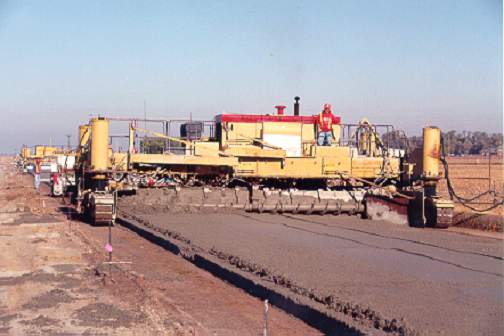
Figure 1: Concrete placement
A test plan for MCL activities was agreed upon that included; 1) maturity testing on three separate placements (one calibration and two verifications) using both flexural and compressive strengths, 2) impact-echo testing for pavement thickness at four locations (thickness verification made with cores), 3) demonstration of the AVA for comparisons to both pressure meter tests and linear traverse measurements, and 4) microwave water content testing for comparison to batch tickets. Data was also gathered for a limited HIPERPAV demonstration as well.
Field sampling and testing commenced on October 11th, 2000, and was completed on October 20th, 2000. The MCL pulled out from the site on the afternoon of October 20th, 2000. Laboratory testing was completed on November 17th, 2000.
1) Maturity Testing:
The maturity method is a technique used to estimate the strength gain of concrete based upon the temperature-time history recorded by a maturity meter. The method is based on the assumption that samples of a given concrete mixture attain equal strengths if they attain equal values of maturity. Both AASHTO and ASTM have applicable standards for the test method.
The main advantage of maturity testing is the ability to measure the concrete strength in-place. By testing the concrete with maturity probes, the number of required quality control specimens is drastically reduced. Both time and cost can be significantly reduced, especially for fast track projects where smaller windows for quality control are available. Testing errors associated with improper specimen handling is also reduced.
The maturity data evaluated for this project shows that maturity testing predicts the in-place concrete strength reasonably well (see Figure 2). All three maturity curves fall on top of each other, indicating that the maturity approach is repeatable for the three different placements. Pavement verification data, from maturity sensors installed in the pavement itself (see Figure 3), suggests that the 24Mpa (3,500psi) strength requirement was satisfied in the pavement approximately 3.5 days after placement for the October 17th placement, and 3.8 days after placement for the October 19th placement. The contractor usually waits 4 days before allowing construction traffic on the concrete pavement.
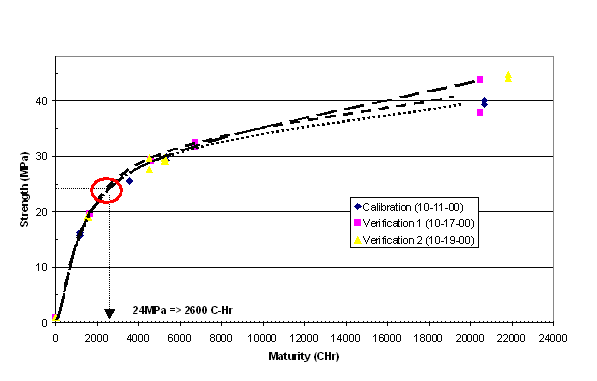
Figure 2. Maturity Data (Compression)
Flexural strength maturity data indicate similar results. Detailed maturity and strength data is provided in Appendix A.
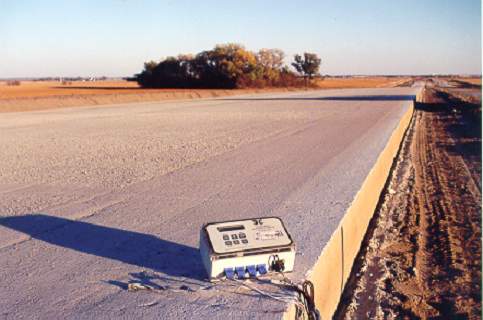
Figure 3. Pavement instrumented with maturity meter
2) Impact Echo Testing:
Impact-echo is a nondestructive testing technique typically used to locate discontinuities such as internal voids, cracks and delaminations in concrete elements. The technique can also be used to determine the depth of concrete slabs/pavements. The impact-echo method employs a mechanical impactor to introduce a stress pulse to the surface of the concrete. The pulse generates stress waves that then propagate through the concrete. These stress waves are reflected by internal interfaces (e.g., cracks, voids, etc.) and by external boundaries of the structure. Reflected waves then arrive at the surface where the impact has occurred and produce displacements, which are measured by a receiving transducer. Multiple reflections from each interface become dominant peaks in the frequency spectrum at values corresponding to the frequency of arrival of reflected waves from each interface. An interface can be the boundary between two materials with different acoustic properties such as the concrete/air interface at a crack, or the bottom of a pavement. The dominant frequency and stress wave speed are used to determine the depth to the interface where the reflection has occurred. The stress wave speed is determined by spacing two transducers a known distance apart on the surface of the concrete, creating an impact adjacent to the transducers, and measuring the time it takes for the wave front to move from one transducer to the second transducer. ASTM Standard Test Method C 1383 gives a detailed description of the equipment and methodology.
Prior to the state's normal coring operations, members of the MCL staff in conjunction with Nebraska Department of Roads personnel randomly selected locations where acceptance cores would be taken. The impact-echo method was used to first determine the stress wave speed at each location and, using that wave speed, impact-echo thickness tests were performed (see Figure 4). The wave speed was determined using an average of four measurements, and the thickness was determined based on an average of three measurements at each location.
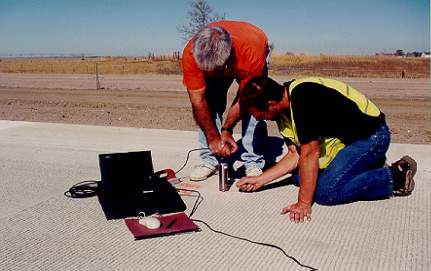
Figure 4: Impact Echo Testing
Table 1 shows the results obtained from four different locations on this project. The impact-echo thickness tests differed with core length measurements by only three to five mm. The average difference was 3.3 mm, or approximately 1.3 % of the measured core lengths. This relatively small difference is probably related to; 1) a consistent and representative wave speed, and 2) a uniform and smooth subbase allowing for sharp reflections at that interface. The consistency in wave speed measurements may be due to the fact that almost 70% of the aggregate is fine compared to most mixtures where 30-40% is more typical. Measurements of the cores confirmed that the surface of this subbase material was very smooth. Overall, the impact-echo measurements are within the range most SHA's currently specify for deficient cores (five mm).
| Location | Average wave speed (m/s) |
Impact-Echo Thickness (mm) |
Core Thickness ASTM C 174 (mm) |
Difference IE-Core Thickness |
|
|---|---|---|---|---|---|
| (mm) | % | ||||
| 26 | 3798 | 251 | 256 | -5 | -2.0 |
| 21 | 3976 | 259 | 262 | -3 | -1.1 |
| 22 | 3974 | 254 | 257 | -3 | -1.2 |
| 23 | 3945 | 251 | 254 | -3 | -1.2 |
| Average | 3923 | 254.0 | 257.3 | -3.3 | -1.3 |
3) Air Void Analysis Testing:
Testing the air content in concrete is important to ensure that the concrete will resist deterioration caused by freezing. For a typical concrete pavement to be freeze-thaw durable, ACI recommends a total air content from 5.5% to 7% by volume. On-site pressure-meter testing is routinely used to measure the total air content of fresh concrete. Although pressure meters are effective in determining the total air content, it does not provide information about bubble size or how that volume of air is distributed throughout the volume of concrete. It is vital for adequate freeze thaw performance to characterize the air void system in this manner. However, there are currently no standardized test methods to determine this on fresh concrete. The only standardized method to determine the air void system is to perform a linear traverse or modified point count (ASTM C-457). Unfortunately, these tests are performed on hardened concrete, and typically take several weeks to complete, when the concrete most likely already has traffic on it. This is why most SHA's do not routinely specify hardened air content tests.
In an effort to address this issue, researchers in Denmark designed the Danish Air Void Analyzer (AVA). The AVA measures the entrained air content, spacing factor and specific surface of the plastic concrete in less than 25 minutes. This allows the concrete producer or contractor to adjust admixture dosages and mixing procedures in real time, to ensure a proper air void system. The basic methodology of the AVA involves expelling all air voids (bubbles) present in a given concrete sample, collecting the air bubbles and recording their quantities and size distribution. The test method involves retrieving a sample of fresh paste, and injecting it into a column of a glycerin solution. The viscosity of the solution allows the individual air bubbles to retain their original size, i.e. neither coalesce nor collapse while the sample is injected in to the solution. The air bubbles then rise through the viscous solution and enters a column of overlaying water. They rise through the water column and collect under a submerged buoyancy recorder. The rising speed of the air voids through the liquids is dependent on their size (according to Stoke's Law), as large bubbles rise faster than small ones. The viscosity of the glycerin solution slows the initial rise of the bubbles and provides a measurable separation in time between the arrival at the top of the column of bubbles of different sizes. From this data, the air void parameters (air content, spacing factor, specific surface) can be calculated. Figure 5 shows a picture of the AVA apparatus.
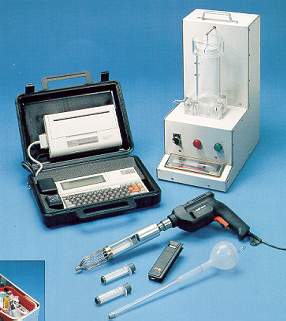
Figure 5: Air Void Analyzer Test Equipment
Unfortunately, only one successful AVA test was performed during our field testing as high winds during testing interfered with proper measurement. The buoyancy recorder in the AVA is extremely sensitive and is affected by slight movements and vibrations caused by wind jarring the Mobile Concrete Laboratory. The comparison linear traverse results from NDOR shows good agreement in terms of entrained air content for the one test we were able to perform. The AVA results indicated an entrained air content of 4.1%, while the modified point count results from Terry Masters of NDOR indicated an entrained air content of 4.07%. The Type B pressure meter measured 5.5% total air - this also agrees well with the AVA results, indicating 1.4% entrapped air. ACI indicates that 1.5% entrapped air is expected for a nominal maximum coarse aggregate size of one inch. However, AVA and modified point count spacing factor and specific surface results did not compare. This may be related to the sensitivity of the AVA to vibrations caused by substantial winds. Due to the nature of the analysis, these parameters are much more sensitive to any movements of the apparatus than are air contents.
4) Microwave Water Content Test:
Water content of as-delivered concrete has always been a source of speculation and uncertainty. Water in excess of the mix design amount can have a direct, negative impact on the strength, quality, and durability of concrete. Wash water in a ready-mixed concrete truck drum, variable aggregate moisture, and addition of water at a job site have been major sources of uncertainty. As better quality control, optimization of materials in the mix design, and high-performance concrete are specified for construction projects, it has become critical that accurate control of the water content of a concrete mix be enforced. Development of the microwave oven method is an attempt to provide a simple, effective way of monitoring water content of concrete at a construction site.
The principle of the test involves placing a test specimen of freshly mixed concrete wrapped in a fiberglass cloth in a heat-resistant glass tray (Pyrex), and drying it in a microwave oven using a minimum of three drying intervals. The test specimen is broken up, separating the coarse aggregate from the mortar, and the mortar is ground with a pestle after the first drying interval. The test specimen is stirred and its mass is determined after each drying interval until constant weight is achieved. The water content of the test specimen is calculated based on loss in mass of the test specimen. The test is fast and allows the water content to be determined in less than 15 minutes. The w/c ratio can then be determined by dividing the amount of water from the microwave tests by the amount of cement indicated on the batch ticket. Figure 6 shows a picture of a test specimen being placed in the microwave.
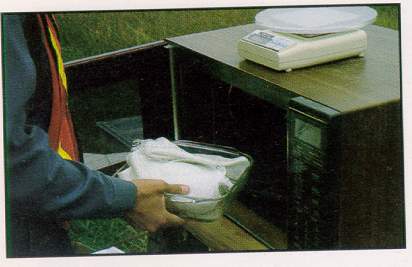
Figure 6: Microwave Water Content Test
Only one microwave water cement ratio test was performed at this project. Results from comparisons to actual batch quantities show good agreement. Both the Microwave w/c ratio test and the batch ticket indicated a w/c ratio of 0.44, compared to the specified maximum w/c ratio of 0.45.
5) HIPERPAV Analysis:
HIPERPAV (High PERformance PAVing) is a Windows-based computer program that is designed to aid the user in minimizing the potential for uncontrolled or mid-slab cracking during the first 72 hours after placement. The program uses a systems approach to integrate material properties with pavement design and construction operations, into one easy to use decision making tool. HIPERPAV can accurately predict the stress and strength behavior of concrete pavements during the critical first 72 hours, using inputs from four different categories, 1) Pavement Design, 2) Mixture Design, 3) Environmental Conditions, and 4) Construction Operations.
Results from the HIPERPAV analysis using inputs from the project site for the placement occurring at 9:00am on October 19, 2001, indicate a relatively high potential for uncontrolled cracking. Although the software did not predict failure, the critical stresses in the top of the pavement were very close to the concrete strength at approximately 5:00am the following morning (see Figure 7). This cracking potential could have been reduced by using blankets during the night to minimize the thermal gradient in the pavement. Field observation indicated that no uncontrolled cracking was observed in this section of the concrete pavement. Detailed HIPERPAV data and analysis are included in Appendix B.
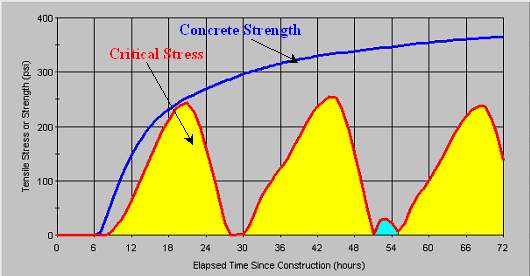
Figure 7: HIPERPAV output for 10-19-01 placement
Conclusions:
Based upon the field and laboratory testing conducted in connection with the construction of US 275 in Valley Nebraska, during the fall of 2000, the following conclusions are drawn:
- Maturity appears to accurately predict the in-place concrete strength for a typical Nebraska concrete paving mixture. Duplicate testing confirms that the method is reproducible over several days of concrete placement as well. For the relatively mild field conditions encountered during the on-site testing, the contractor could have allowed construction traffic on the pavement 12 hours earlier than normally allowed. For summer placements however, the time savings associated with using maturity for early opening to traffic decisions will be greater.
- Results from impact-echo testing indicate that the method is promising for evaluating pavement thicknesses nondestructively. The results agree well with measured cores, and the differences were in all cases less than 5mm.
- AVA testing was inconclusive due to lack of data. Although measured entrained air content agreed very well with both the pressure meter test and the modified point count results for the one test, the spacing factors and specific surface results did not compare. This was most likely due to the excessive sensitivity of the AVA method to external movement/vibration due do wind.
- The microwave water content test was successful in determining the w/c ratio of the plastic concrete. Both the microwave water content test and the batch ticket indicated a w/c ratio of 0.44.
- HIPERPAV analysis indicated a relatively high potential for uncontrolled cracking although none was observed within the first 2 days. The analysis indicated that the most critical time period for failure was at approximately 5:00am the morning following the placement.
All available raw test data was provided to Scott Grossenbacher with NDOR during the fall of 2000 and winter 2001. If you have any comments or questions about these findings/results, please contact Geoffrey Kurgan, Concrete Materials Engineer with the Mobile Concrete Laboratory at (202) 366-1335 or geoffrey.kurgan@fhwa.dot.gov.

